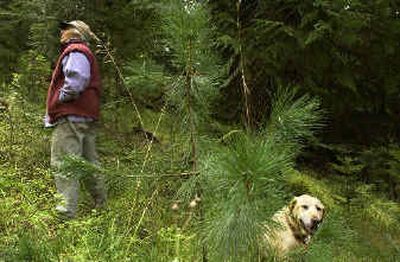Class teaches care of private forests

The lure of living in a forest was powerful for Jane and Bob Takai.
But after the couple bought a large tract of land near Newman Lake 20-some years ago, they quickly became aware that pretty scenery doesn’t come easily. Their woods were full of all sorts of unseen perils: root rot, noxious weeds, hungry beetles and thick stands of trees itching for a burn.
“We knew nothing,” Jane Takai said Thursday as she walked across a wooded hillside near her home. “We didn’t know anything about trees. We didn’t even know the kind of trees that grew here.”
The Takais own just a sliver of Spokane County’s 250,000 acres of private forestland, which is twice the land devoted to growing wheat, said Peter Griessmann, a forestry educator for the Washington State University Extension. Unlike wheat fields, however, much of the private forestland is left untouched and the results are beginning to show.
Diseases, weed infestations and fire-prone stands of trees are becoming more common, Griessmann said. “I see a lot more people coming in from out of the area, retiring in the Inland Northwest and owning forest. It’s imperative they understand what’s required to keep that forest healthy.”
Next week, Griessmann will begin teaching a course on forest management for Spokane County landowners. The six-week course meets once weekly and covers everything from wildlife and soils to developing a timber harvest plan. Graduates are eligible for a variety of state cost-sharing programs.
The Takais took a similar course years ago. It helped them realize that their beautiful landscape might have been created by nature, but human effort is sometimes needed to protect the scenery.
“There’s a lot to learn,” Jane Takai said. “Sometimes it’s overwhelming. I realized it’s going to take a lifetime to do it all.”
For more than a decade the couple have been working to return some balance to the land. Without the natural fire cycles, their forest was overgrown and increasingly crowded with undesirable tree species. They have since planted hundreds of white pine, Western larch and ponderosa pine seedlings. They carefully apply herbicides to control the spotted knapweed, dalmatian toadflax and other invading weeds.
Much of the work has involved thinning the forest. Takai compares it with growing carrots – the young plants need to be thinned to produce healthy, mature specimens. Pulling baby carrots, though, takes less effort than clearing acres of spindly fir trees.
“We don’t do anything else, but it’s our joy,” Takai said. “We don’t take vacations. We work in our forest.”
Like many Spokane County residents, the Takais’ goal is not timber income but forest health. They like living in a forested setting and want to be surrounded by tall, lush trees. Griessmann, the WSU Extension agent, said the Takais are an exception. Many of the region’s small-scale landowners often mistakenly believe a hands-off approach is the best way to manage a forest.
“People tend to say they bought the property for scenic reasons,” Griessmann said. “But if the trees are dying, the scenery’s gone.”
Griessmann also noted that healthy private forests are vital for the Inland Northwest’s natural resource-based businesses. In 2002, Spokane County forests produced about 31 million board feet of timber – enough to build more than 2,000 new homes. More than 80 percent of the timber came from private land.
Private forests play an even larger role in the economies of Stevens and Pend Oreille counties, where two sawmills take in about $625,000 worth of logs each day, Griessmann said.
“If it wasn’t for the private land, our mills would have gone belly up years ago,” Griessmann said. “The worrisome trend is how long can private lands sustain the sawmills?”
With timber prices at record-high levels many landowners are considering cutting some of their trees. Griessmann worries that people without a long term forest management plan could be making a once-in-a-lifetime cut. A properly managed forest can produce income over many years, he said. They’re also nice places for a summer afternoon picnic.